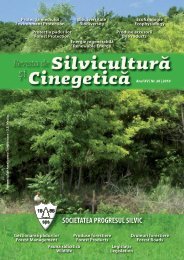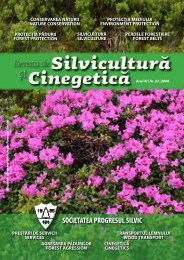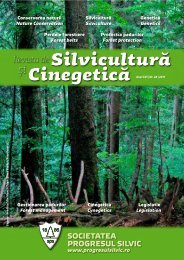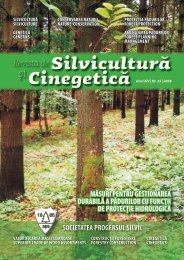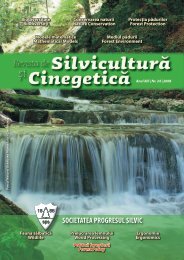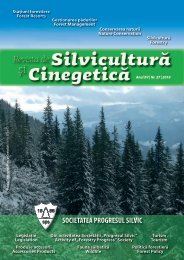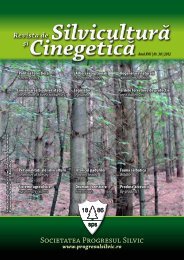Silviculture and Cinegetics Review - Societatea Progresul Silvic
Silviculture and Cinegetics Review - Societatea Progresul Silvic
Silviculture and Cinegetics Review - Societatea Progresul Silvic
You also want an ePaper? Increase the reach of your titles
YUMPU automatically turns print PDFs into web optimized ePapers that Google loves.
FORESTRY BELTS SILVICULTURE AND CINEGETICS REVIEW XVII/30/2012<br />
To achieve the GIS analysis of the existent<br />
information in order to assess the area to be planted<br />
with forest shelterbelts for field protection, but, also,<br />
to identify the corresponding areas for different<br />
afforestation solutions, the following information<br />
sources (data) were used:<br />
• Geomorphological map included in the atlas of<br />
Romania (Institute of Geography), printed in 1976,<br />
has been used to delineate the two geographical units<br />
(the Danube Plain <strong>and</strong> Dobrogea), carrying out the<br />
layers of polygons that highlights the two regions.<br />
• Ortophotoplans were used to accurately identify the<br />
arable l<strong>and</strong> <strong>and</strong> pastures. On the ortophotoplans the<br />
outlines of arable l<strong>and</strong>s <strong>and</strong> pastures were vectorized,<br />
to which was assigned the appropriate code (arable<br />
l<strong>and</strong> or pasture). Through this operation the areas<br />
which are not subject to the establishment of the forest<br />
shelterbelts network for field protection, have been<br />
eliminated from the very beginning (orchards,<br />
vineyards, social-economic objectives, built<br />
settlements, forest areas etc.).<br />
• Administrative maps at county level scale 1:100.000<br />
were scanned, georeferenced <strong>and</strong> used to vectorize the<br />
joint limits. After their vectorization corresponding<br />
attributes (commune name, Siruta code, <strong>and</strong> the<br />
county they belong to) have been introduced.<br />
Therefore, resulted the polygon layer with<br />
administrative units (communes, counties).<br />
• Soil maps 1:200.000 made by the Institute of<br />
Geology in 1969 have been scanned, georeferenced,<br />
<strong>and</strong> then vectorized, introducing the corresponding<br />
characteristics of each soil type <strong>and</strong> resulting thus a<br />
GIS data base of the studied area soils.<br />
At this stage, using the pedological criteria, the<br />
floodplains areas with alluvial soils (usually s<strong>and</strong>y)<br />
have been delineated, that have not been taken into<br />
consideration, because they are considered as<br />
wetl<strong>and</strong>s <strong>and</strong> the necessity of establishing forest<br />
shelterbelts is lower (also questionable) <strong>and</strong> also such<br />
areas show a low productive potential to agriculture<br />
(being more suitable for larger-scale afforestation).<br />
• GPS data were collected through field visits<br />
conducted in the s<strong>and</strong>y soil areas identified in the<br />
above-mentioned data base. Visiting some of such<br />
areas it was observed the fact that they have extended<br />
<strong>and</strong> their extending boundaries were marked (by<br />
points or continuously) using GPS Trimble equipment<br />
class GIS type GeoXT <strong>and</strong> Geo XM <strong>and</strong> the Trimble<br />
TerraSync software. For an easier identification georeferenced<br />
images were used (ortophotoplans with the<br />
limits of the s<strong>and</strong>y areas or the topographic maps)<br />
uploaded in the GPS.<br />
The GPS data were downloaded <strong>and</strong> processed at the<br />
office stage by the Trimble Pathfinder Office software<br />
<strong>and</strong> finally were integrated in the GIS system.<br />
Using the GPS data <strong>and</strong> the existent pedological data,<br />
has been assessed an estimation of the extension of<br />
the s<strong>and</strong>y soils areas <strong>and</strong> it has been materialized in<br />
this extended database.<br />
Based on this estimation, the areas with s<strong>and</strong>s <strong>and</strong><br />
s<strong>and</strong>y soils were delineated, that also were not taken<br />
into consideration, requiring a specific approach,<br />
different from the one used for the field forest<br />
shelterbelts, due to the low agricultural productivity<br />
<strong>and</strong> to the additional aridity determined by the<br />
extended s<strong>and</strong>s.<br />
2.2. Generation of shelterbelts network <strong>and</strong><br />
GIS analysis<br />
• The network of forest shelterbelts with theoretical<br />
dimensions of 600 m x 1200 m has been automatically<br />
generated for the entire country area, following that<br />
after the clipp type GIS analysis only the area which is<br />
the objective of this stage.<br />
• GIS Analysis. Finally, by using the GIS data layers<br />
could be carried out the specific spatial analysis. In<br />
pursuance of the spatial analysis have resulted the GIS<br />
data necessary to establish the areas corresponding to<br />
the afforestation solutions, on geographical units, l<strong>and</strong><br />
use categories <strong>and</strong> administrative-territorial units. For<br />
this purpose the GIS ArcGIS 9.2 software has been<br />
used.<br />
The main factors that have to be taken into account in<br />
the settlement or distribution of the forest shelterbelts<br />
on the administrative area of the localities in case of<br />
design the shelterbelts network at the localities level<br />
are: topography, surface shape, climate, soil <strong>and</strong><br />
bedrock, hydrologic conditions of the region<br />
(represented by groundwater, surface waters courses<br />
<strong>and</strong> the irrigation canals network), spontaneous <strong>and</strong><br />
cultivated woody vegetation, the work methods <strong>and</strong><br />
the machinery used in agriculture, as well as the<br />
railways, highway <strong>and</strong> roads of general use network.<br />
Depending on these factors the necessary basic<br />
elements for shelterbelts establishment are<br />
determined, as following: orientation, distance, width<br />
<strong>and</strong> openings between shelterbelts.<br />
For knowing of the l<strong>and</strong> shape the localities<br />
topographical plans at 1:10000 or 1:5000 scale are<br />
used, obtained from the specialised units (National<br />
Agency of Cadastre or county l<strong>and</strong> registration<br />
offices).<br />
52



